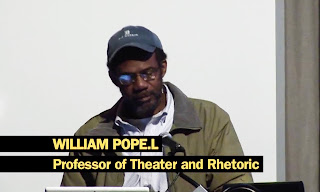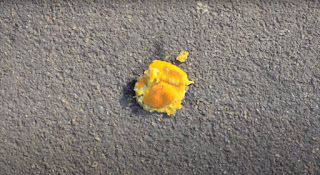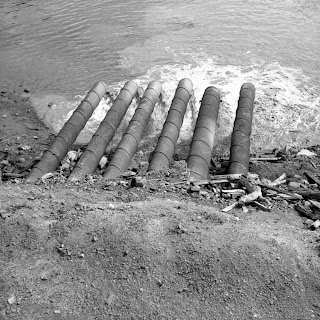Still: Hito Steyerl's How Not to Be Seen (2013)
Saturday, September 26, 2020
Tuesday, September 15, 2020
Visiting Artist Lecture: Paul Mpagi Sepuya, 6:15PM, Tuesday, September 15, 2020
To access the Tuesday' Sept. 15th talk, 6:15PM join Zoom Meeting
Meeting ID: 939 2451 1495
Paul Mpagi Sepuya is represented by by Team (New York, Los Angeles), Document (Chicago) and Vielmetter Los Angeles. Document will present a solo booth by Paul Mpagi Sepuya in the Positions sector during Art Basel Miami Beach 2019. Camera and edit: Gillian Garcia Production: Coline Milliard and Jeanne-Salomé Rochat for Art Basel.
A slew of exhibitions, including the Whitney Biennial and recent shows at the Guggenheim Museum and the Getty, have put Paul Mpagi Sepuya’s name on everyone’s lips. The Angelenoartist re-examines portrait photography’s formal and conceptual foundations, as well as its traditional tools: mirrors, black velvet, and darkrooms. Questions around the representation of the black and the queer body – be it his own or his friends’ and collaborators’ – also inform Sepuya’s sensitive and intimate body of work. He welcomed Art Basel in his Boyle Heights studio.
Paul Mpagi Sepuya (b. 1982, San Bernardino, CA) is an artist working in photography whose projects weave together histories and possibilities of portraiture, queer and homoerotic networks of production and collaboration, and the material and conceptual potential of blackness at the heart of the medium. His work is in the collections of The Museum of Modern Art, the Whitney and Guggenheim Museums, The Studio Museum in Harlem, The Getty Museum and MOCA Los Angeles, among others. His work has been reviewed in the New Yorker, the New York Times, Art in America, and he was featured on the cover of ARTFORUM’s March 2019 issue. Sepuya has been in recent exhibitions at the Whitney Museum, New York, Guggenheim Museum, New York, the Barbican Centre, London, and the Getty Museum, Los Angeles. A survey of work from 2008 - 2018 was presented at CAM St. Louis and University of Houston Blaffer Art Museum, accompanied by a monograph published by CAM St. Louis and Aperture Foundation. He is Acting Associate Professor in Media Arts at the University of California San Diego.
LESLIE HEWITT "READING ROOM" AT PERROTIN NEW YORK
LESLIE HEWITT "READING ROOM" AT PERROTIN NEW YORK video here
Leslie Hewitt
On the occasion of her solo exhibition at Perrotin New York (September 11 – October 26, 2019), Leslie Hewitt talks about Lewis Michaux, a Harlem bookseller and civil rights activist who inspired the show. She also explains her attraction to minimalism, and the connection between her photographic work and the Dutch still life paintings of the 16th and 17th century.
Artie Vierkant "Rooms Greet People by Name", Perrotin New York
Artie Vierkant uses augmented reality to put his art in your hands
By Drew Zeiba •
Brooklyn-based artist Artie Vierkant melds photography, commercial printing, and sculpture. For Vierkant, there is no real hierarchical distinction between art experienced in real life or in a photograph. In Vierkant’s post-digital world, 2-D and 3-D, image and object, original and copy, exist on a level playing field. He often takes photos of his installation, modifies them, and repurposes them as new works in and of themselves.
Most recently, this has taken the form of an augmented reality (AR) app, Image Object (a term Vierkant termed in 2010 to describe work which “exist[s] somewhere between physical sculptures and altered documentation images”), released in conjunction with his exhibition Rooms greet people by name at Galerie Perrotin on the Lower East Side. Vierkant sat down with the Architect’s Newspaper to discuss the app, the boundaries between 2-D and 3-D, and what augmented reality means for the future of public space.
Read more here
SculptureCenter at The New School: Expanded, Exploded, Collapsed?, April 19, 2010
SculptureCenter, The New School: Expanded, Exploded, Collapsed?, 4 /19/10, Part 1 here
SculptureCenter, The New School: Expanded, Exploded, Collapsed?, 4/19/10, Part 2 here
Thirty years on from Rosalind Krauss’ seminal text Sculpture in the Expanded Field, a panel of artists and critics reconsiders the concept of the "expanded field" in light of contemporary art production. Co-sponsored by the Vera List Center for Art and Politics, the discussion reflects upon how performative, discursive, and design models developed since the essay's publication may have shifted the formal, political, and semiological parameters of sculpture today.
Moderator
Fionn Meade, Curator, SculptureCenter
Participants
Johanna Burton, art historian and critic
Josiah McElheny, sculptor and faculty member, Yale University
William Pope.L, performance artist and Professor of Theater and Rhetoric, Bates College
William Pope.L Yard By Yard
By Mary Barone, Oct. 6, 2009
By the late 1950s... Allan Kaprow (1927–2006) began to consider the ‘action’ component of Action Painting far more important than the painting part. In 1959, the painter who set off countless gestures orchestrated 18 Happenings in 6 Parts, a series of actions seemingly spontaneous and unrelated, but actually tightly coordinated directives. In 1961, for Yard, Kaprow filled the backyard of an uptown art gallery, the Martha Jackson Gallery, with old tires and tar paper, giving birth to what we once called “happenings” and now have settled on as “performance art.”
Kaprow reinterpreted Yard in other locations ten times before his death, and he encouraged other artists to reinvent his works by keeping simple instructions. Hauser & Wirth Gallery invited Helen Molesworth to take Kaprow up on his offer. Molesworth invited three artists—Josiah McElheny, Sharon Hayes, and William Pope.L—to intervene. The latter was the only to reinvent YARD at the gallery’s 32 East 69th Street location, and is the artist who followed Kaprow closest to the letter Yard (To Harrow) used real tires in the space, although combined them with some materials not in the original instructions—like body bags.
MARY BARONE: I’m told Kaprow first conceptualized YARD as a cross between a junk pile and a funhouse. Your reinvention Yard (To Harrow), with its changing light effects and mirrored walls, draws the viewer through the gallery’s darkened entry hall into what seems to be a ‘fun-house’—but approaching a pile of cascading rubber tires mounted on a platform of body bags is hardly my idea of fun. Why the body bags? (LEFT: PHOTO BY MARY BARONE)
WILLIAM POPE.L: The body bags reference the body bag-like containers Kaprow constructed out of tarpaper around the figurative sculptures [a Hepworth, a Giacometti] in Martha Jackson’s courtyard. Kaprow wanted to hide something–I wanted to show something.
BARONE: You were supposedly given a copy of Kaprow’s meticulously worded, deceptively, simple set of master instructions for future presentations of YARD. Was it your idea to bring the work back inside an enclosed gallery space as a device to compel the viewer to reconsider traditional values, traditional themes?
POPE.L: I was given two things by the Kaprow Estate: a binder containing clippings; newspaper texts of almost all past YARD reinventions, both Kaprow’s and others as well as the book Allan Kaprow: Art as Life. I did my own research and looked at the environments book by Allan Kaprow, the J. Kelley book and a few other things. I re-read parts of Pynchon’s ‘Gravity’s Rainbow,’ and some interviews with the filmmaker David Cronenberg published in 1997.
The original courtyard space at 32 East 69th Street has since been covered over but you could say my reinvention is in almost the same area as Allan Kaprow’s 1961 YARD except now it has a lid. Hauser & Wirth and the Estate chose the site.
I believe that Kaprow discovered something but didn’t realize it’s full import until years later. He discovered that art was inexorably moving out into the world. On the other hand, Allan Kaprow was trained as a formalist modernist who must believe there is something that is specific to art that makes it art. There’s a tension in Allan Kaprow re: the split between art and life. I see this in art in general and I find the tension productive.
So when Hauser & Wirth and the Kaprow Estate chose a gallery for a artwork whose radicality partly derived from not being in a gallery, I felt it was necessary to bring some world back in. Not only materially but tonally. Today the American automobile experience is inextricably tied to otherness (mid-east oil, Toyota, Iraq, Afghanistan) and a fallen Eden (bad ecology, bankrupt car companies). And the voice (Obama) that we’ve chosen to speak our paradox, our crisis is intimately attached to otherness. Perhaps some of this is political, I know it’s not pure or clean or comfortable. And putting a lid on things does not necessarily mean ignoring or softening them, it can also intensify an experience. In the case of rubber tires that are constantly oxidizing into the air, housing them in an enclosed space guarantees we will, as an audience, have to breathe in the very molecules the tires give off. Even though Kaprow championed the notion of blurring the line between life and art, (human molecules and non-human molecules) he was wary of including politics in his idea of life. I find this odd, human surely, but odd even so. (LEFT: PHOTO BY MARY BARONE)
BARONE: You said you were struck by Kaprow’s “playful impetus” in the first version of YARD, “his invitation for people to touch the tires, move them around, climb into them, was an end in itself, art for art’s sake, essentially upbeat.” Can you explain the importance of the “upbeat” tone?
POPE.L: I think that “upbeat” as a tone is a very American way of speaking. We like a happy ending. It’s a way of indicating to a viewer that no matter what you see, no matter what you experience, no matter what you know to be true, it’ll be all right. I think Kaprow suspected his insistence on the play could be mistaken for lack of rigor, radicality or seriousness of purpose but at the same time, play was a very human means to avoid the dark. And as a true American black man, fully born into the cultural vise, I am all for the dark.
William Pope.L’s Yard (To Harrow), 1961/2009 is on view through October 26. Hauser & Wirth is located at 32 East 69th Street, New York.
Thursday, September 3, 2020
Brassai and Involuntary Sculpture
According to the Metropolitan Museum of Art, "Brassaï collected and photographed tiny castoff scraps of paper that had been rolled, folded, or shaped unconsciously by idle hands-readymade Surrealist objects that represent what Rosalind Krauss has described as "the automatic writing of the world." A selection of these images was published in the following year in the avant-garde magazine Minotaure accompanied by captions written by Salvador Dali."
"What happens when sculpture ceases to be quite so controlled, when
it lets itself be dictated by principles of chance, determined by its environment
or by the circumstances of its reception and documentation? For the brute
activities listed above we could substitute a different set of much less ‘voluntary’
ones: fingering, fiddling, propping and shuffling, to which should be added the
instantaneous snapping of the camera lens. Where sculpture is ‘found’ and not
‘made’, or indeed exists somewhere between the two, it can also become less
material and more obviously contingent – a form of a thing, or a formation of
things, captured at a specific time. If ‘voluntary’ sculpture suggests the production
of a deliberate material configuration, set forever in hard matter, ‘involuntary’
sculpture points to its own transience or its role as part of an ongoing process,
where it exists beyond a serendipitous photographic image.
This volume takes its cue from a selection of photographs by Brassaï with
captions by Salvador Dalí published in the surrealist periodical Minotaure in 1933
and bearing the title ‘Involuntary Sculptures’ (Figure I.1). Scraps of everyday
debris – including rolled-up bus tickets, a piece of bread roll, a curl of soap from a
sink and a blob of toothpaste – featured in photographic close-up as ‘automatic’
sculptural configurations. These banal and non-artistic objects (one of the tickets
was allegedly found screwed up in the pocket of a bank employee) were intended
at least in part as a riposte to the prevailing perception of sculpture at the time...
Brassaï and Dalí’s photo-essay provides a tantalising evocation of sculptural
possibility, where forms are both shaped by human hands, sometimes with
little conscious thought (the rolled bus ticket), and subject to ‘organic’ growth
(the piece of bread rising and changing shape in the oven). It also freezes its
array of objects at a given moment, before they are discarded, swept or wiped
away, dissolved or eaten... the parameters of ‘sculpture’ are challenged and expanded,
while photography fulfils simultaneous (and potentially contradictory) functions
of auratic reproduction and quasi-scientific documentation."
-Anna Dezeuze and Julia Kelly
Matt Calderwood, Scraps, 2011
Matt Calderwood, The Streets Present Scraps here. Calderwood's website here
According to the Guardian, Matt Calderwood was, "Born in Northern Ireland in 1975, Calderwood studied Fine Art at Newcastle and Sunderland. When not putting his materials through their paces in one of his perilous performances, he builds monumentally unstable sculptures out of plywood that rely on counterbalance to keep them steady. Both sculptures and performances require a steely control in the artist, and it is this paradox, the struggle of power between artist and objects, that makes his artwork so riveting. "
Christine Hill - Volksboutique
Christine Hill Volksboutique video here
Volksboutique project website here
Chistine Hill biography:
A resident of Berlin since 1991, American artist Christine Hill has spent her artistic career trying out other careers. Referring to these experiments as “organizational ventures,” rather than performance art or installations, she has opened ad-hoc businesses as varied as a tour guide company, a portable office, a massage parlor, and an apothecary. One of her most enduring works is the Volksboutique, which is comprised of a series of small shops that have popped up around the world. The small businesses combine the tradition of East German community shops—stocked by products made in her studio, the Volksboutique Products Division—with optimistic slogans rendered in red, white, and blue text. Like Andy Warhol, she continues the 20th-century tradition of exploring the relationship between art and commerce, with a bit of theater rolled in.











